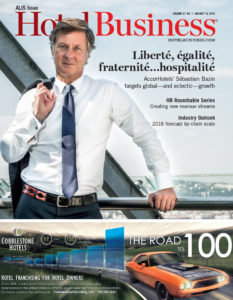Experts are predicting a slight dip in occupancy and modest gains in rate and RevPAR for the upper-upscale hotel segment in 2018, which is largely composed of large, meetings-focused full-service hotels in key markets. New supply, sluggish group demand and presently high occupancy levels are all expected to keep growth in the segment relatively minimal in the coming year.
Although the pipeline for new upper-upscale hotels is showing 2.3% supply growth in 2018—nowhere near the level of the upscale segment’s new supply, for example, which is projected at 5.8%—demand for upper-upscale hotels is only expected to grow 1.8% this year, according to CBRE Hotels. Sources told Hotel Business the supply-demand imbalance can be attributed to factors like subpar group demand, as well as travelers trading down to popular, trendy upscale brands.
“Maybe groups are still meeting, but some of those attendees are trading down to the upscale tier, where we’ve seen some very significant supply,” said Mark Woodworth, senior managing director of CBRE Hotels’ Americas Research. “Most people would say, ‘I prefer to stay in something new and fresh, rather than something old that’s not so fresh.’ Those are some of the things that we think are contributing to somewhat weaker pricing power in the upper-upscale segment, even though occupancy levels are staying high.”
 That’s why sources are calling for another steady year, but one with modest declines in occupancy and slight gains in ADR and RevPAR. CBRE is expecting a minor occupancy dip of -0.5% to 73.5% overall, an ADR gain of 1.5% to $184.88—the smallest percentage ADR gain of all segments—and RevPAR growth of 1% to $135.92. STR is projecting similar numbers for the segment, with a year-end 2018 occupancy decline of -0.3%, ADR growth of 1.4% and a RevPAR increase of 1.2%.
That’s why sources are calling for another steady year, but one with modest declines in occupancy and slight gains in ADR and RevPAR. CBRE is expecting a minor occupancy dip of -0.5% to 73.5% overall, an ADR gain of 1.5% to $184.88—the smallest percentage ADR gain of all segments—and RevPAR growth of 1% to $135.92. STR is projecting similar numbers for the segment, with a year-end 2018 occupancy decline of -0.3%, ADR growth of 1.4% and a RevPAR increase of 1.2%.
“As far as the occupancy side of things goes, it’s kind of hard in most chain-scale groups, especially at the upper end, for that to increase a whole lot because it’s already pretty high,” said Bobby Bowers, SVP of operations for STR. “The occupancy rates at upper-upscale hotels are really high still. They’re down a little bit from where we were in 2016, but just marginally. In most of those kinds of properties, the days you would have the opportunity to grow occupancy are the days that nobody wants to stay in a hotel, like a Sunday night or a Monday night. It’s going to be hard, in my view, to really bump upper-end occupancy up a whole lot.”
Woodworth said a confluence of factors aside from just current occupancy levels are also informing projections for 2018. This “perfect storm” of factors is impacting the segment’s ability to push much higher than where it is already performing.
“There’s been a suspicion for some time now that many meeting attendees are coming to that city and going to the convention center for their primary event, but they’re not staying in the block of rooms that was set aside by the meeting planner,” he said. “Why? Because of the brands they’re loyal to, or they don’t like the big hotel experience, or they found a better price by searching the internet. All these things conspire to really understate the level of demand coming to these properties.”
Since much of the segment’s ongoing performance is in fact intrinsically tied to trends in group demand—specifically large, convention-sized groups—upper-upscale hoteliers remain highly focused on that demand sector. Predictions to this end for 2018 remain cautiously optimistic, with sources expecting brisk group business again this coming year, even if it doesn’t expand much beyond what was seen in 2017.
“We don’t think meetings or group business are going to go away,” said Marty Collins, CEO of Gatehouse Capital. “Does it shift around? I think so. There’s a lot more go-to business than there is drive-to or fly-to, but I think there’s good demand in all of that. I think meetings are going to stay fairly robust.”
And, apparently, upper-upscale demand remains strong enough—as evidenced by the segment’s continually strong occupancy—to fuel continued development in the sector. Despite the hefty price tag associated with a new-build, upper-upscale hotel, some developers are still planning on breaking ground on new projects in 2018.
“We are working on more development projects than we have in 10 years,” said Greg Champion, president/COO of Benchmark. “Lenders are interested and excited about the ‘right’ projects.”

